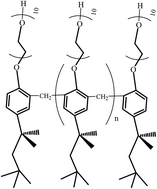Smart stimuli-responsive fluorescent vesicular sensor based on inclusion complexation of cyclodextrins with Tyloxapol†
Abstract
Novel fluorescent vesicles based on inclusion complexes of β-cyclodextrins (β-CD) with Tyloxapol were constructed. For comparison, α-cyclodextrins (α-CD) were also selected to form inclusion complexes with Tyloxapol. The vesicles formed by β-CD/Tyloxapol were characterized thoroughly using various techniques including phase behavior observation, transmission electron microscopy (TEM), freeze fracture transmission electron microscopy (FF-TEM), field emission scanning electron microscopy (FE-SEM), atomic force microscopy (AFM), 2D 1H–1H ROESY NMR, fluorescence spectra, Fourier transform infrared (FT-IR) spectroscopy, and X-ray diffraction (XRD). The results of TEM, SEM, FF-TEM, AFM indicated the formation of vesicles of β-CD/Tyloxapol; they presented aggregation-induced emission enhancement properties because the alkyl chain of Tyloxapol molecules enters the cavity of β-CD and forms inclusion complexes, while α-CD/Tyloxapol showed aggregation-induced quenching fluorescence emission properties owing to the interaction between PEO chain of Tyloxapol molecules and α-CD. Moreover, the vesicles of β-CD/Tyloxapol were responsive to external stimuli and their fluorescent intensities were changed by various environmental conditions such as urea, phenylalanine, α-amylase and NaOH. These properties made our vesicle a promising candidate as novel, smart, stimuli-responsive, fluorescent vesicular sensors.


 Please wait while we load your content...
Please wait while we load your content...